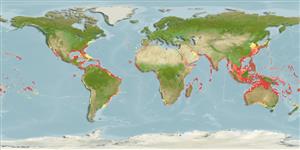Elasmobranchii
板鳃亚纲 (鲨鱼与 鱼) (sharks and rays) >
Carcharhiniformes (Ground sharks)
白眼鮫目 (Ground sharks) >
Carcharhinidae (Requiem sharks)
白眼鮫科 (Requiem sharks)
Etymology: Carcharhinus: karcharos (Gr.), sharp or jagged; rhinus, an ancient name for sharks, from rhine (Gr.), rasp, both words alluding to a shark's jagged, rasp-like skin. (See ETYFish); leucas: From leukos (Gr.), white, referring to its body color, usually grayish with white underside [authorship often attributed to Müller & Henle, who published Valenciennes’ description]. (See ETYFish).
Environment: milieu / climate zone / depth range / distribution range
生态学
海洋; 淡水; 半咸淡水 礁区鱼类; 非产卵性溯降河的 (Ref. 51243); 深度上下限 1 - 164 m (Ref. 106604), usually 1 - 30 m (Ref. 55183). 亞熱帶的; 42°N - 39°S, 180°W - 180°E (Ref. 55182)
Cosmopolitan in tropical and subtropical waters (Ref. 81283): widespread in warm oceans, rivers and lakes (Ref. 4716). Western Atlantic: Massachusetts, USA to Argentina (Ref. 58839); eastern Atlantic: Morocco, Senegal to Angola (Ref. 81283, 81623); Indo-Pacific: Kenya and South Africa to India, then, Viet Nam to Australia; southern Baja California, Mexico to Ecuador and possibly occurring in Peru. Africa: in freshwater found in rivers of West Africa from Gambia River to Ogowe River (Ref. 81283) and in the Cuanza in Angola (Ref. 120641).
Sympatric with Carcharhinus amboinensis, Glyphis gangeticus.
廣泛分佈於溫暖的海洋,河川與湖泊。 西大西洋: 美國麻薩諸塞州到巴西南部。 東大西洋: 摩洛哥, 塞內加爾到安哥拉。 印度-西太平洋: 肯亞與南非至印度, 然後, 越南到澳洲。 東太平洋: 墨西哥的下加利福尼亞南部到厄瓜多而且可能地出現在祕魯。 與 高鰭真鯊〔Carcharhinus amboinensis〕 , 恆河白眼鮫〔Glyphis gangeticus〕 重疊分佈了。
Length at first maturity / 大小 / 重量 / 年龄
Maturity: Lm 201.0, range 180 - 230 cm
Max length : 360 cm TL 雄鱼/尚未辨别雌雄; (Ref. 85726); 400.0 cm TL (female); common length : 260 cm TL 雄鱼/尚未辨别雌雄; (Ref. 9253); 最大体重: 316.5 kg (Ref. 40637); 最大年龄: 32 年 (Ref. 42004)
背棘 (总数): 0; 背的软条 (总数): 0; 臀棘 0; 臀鳍软条: 0. Diagnosis: Carcharhinus leucas is a massive shark with a short, broad and blunt snout, small eyes and triangular saw-edged upper teeth, and lack of interdorsal ridge, characters which are sufficient to distinguish this species (Ref. 26938).
一大的鲨鱼有一个短的,宽的与钝的吻又小的眼与三角形的边缘锯状的上颚齿; 而且缺乏间背脊充份区别这种.(参考文献 26938) 第一背鳍宽而三角形的与少于 3.2 倍第二背鳍鳍的高度; 没有间背脊.(参考文献 5578) 浅灰色的上方, 腹面白色的;(参考文献 5578) 鳍有深色的末端, 尤其在幼鱼中.(参考文献 9997)
A coastal and freshwater shark inhabiting shallow waters especially in bays, estuaries, rivers, and lakes (Ref. 244). It readily penetrates far up rivers and hypersaline bays and littoral lagoons (Ref. 9997, 44894, 81283). Capable of covering great distances (up to 180 kilometers in 24 hours), moving between fresh and brackish water at random (Ref. 44894). Adults often found near estuaries and freshwater inflows to the sea; young enter rivers and may be found hundreds of km from the sea (Ref. 4967, 44894, 58304). Feeds on bony fishes, other sharks, rays, mantis shrimps, crabs, squid, sea snails, sea urchins, mammalian carrion, sea turtles, and occasionally garbage (Ref. 244, 5578, 44894). Viviparous (Ref. 50449). Gives birth to litters of up to 13 young (Ref. 26938, 44894). Size at birth is 56-81 cm TL (Ref. 81623). Sexual maturity is attained after 10-15 years (at a length between 160-200 centimeters) (Ref. 44894). Though not commercially important, this species is a good food fish (Ref. 12484). Utilized fresh, fresh-frozen or smoked for human consumption, fins for soup, hide for leather, liver for oil, and carcass for fishmeal (Ref. 244). Very hardy and lives well in captivity (Ref. 244). This large shark is potentially dangerous to man (Ref. 81283), probably the most dangerous species of tropical shark (Ref. 244), and it is repeatedly implicated in attacks on humans (Ref. 4967, 44894); attacks in fresh water are rare (Ref. 44894).
一只海岸与淡水的鲨鱼在海湾,河口,河与湖中居住于浅水域尤其。 轻易地深入在河川最上游与高盐度海湾。 (参考文献 9997,44894) 能够覆盖长距离 (在 24 小时内向上到 180 公里处), 在淡水与半咸淡的水之间移动随意.(参考文献 44894) 成鱼时常在河口与淡水水域流入海洋的附近发现。 幼鱼进入河而且可能被发现于数以百计公里远距离海洋。 (参考文献 4967,44894) 吃硬骨鱼类,其他的鲨鱼,魟,螳螂虾,螃蟹,乌贼,海洋蜗牛,海胆,哺乳动物腐肉,海龟, 与偶然地垃圾.(参考文献 244,5578,44894) 非常強韌與生存得很好在繁殖場, 熱帶鯊魚 (參考文獻 244) 的可能最危險種, 它是關係到重複的對人類的攻擊.(參考文獻 4967,44894) 對淡水的攻擊是稀有的。 (參考文獻 44894) 胎生的.(參考文獻 50449) 每胎生產向上到 13個幼魚。 (參考文獻 26938,44894) 性成熟被達到在 10-15之後數年 (在 160-200個公分之間的長度).(參考文獻 44894) 生鮮使用, 生鮮冷凍或煙燻了供人類消費 , 鰭用於湯, 隱藏用做皮革,肝臟用於製造魚肝油與殘骸用於魚粉.(參考文獻 244)
Life cycle and mating behavior
成熟度 | 繁殖 | 产卵场 | 卵 | 孕卵数 | 仔鱼
Viviparpous, with a yolk-sac placenta, 1-13 young in a litter. Size at birth about 60 cm TL (Ref. 9997). In the western North Atlantic off Florida and the Gulf of Mexico, and off South Africa, young are born in late spring or early summer. Off Nicaragua, females may have young throughout the year, with a peak in spring and early summer. Estimated gestation period is 10 to 11 months (Ref. 244). Distinct pairing with embrace (Ref. 205). Females often have courtship scars, but males are rarely seen with fighting scars (Ref. 244).廣泛分佈於溫暖的海洋,河川與湖泊。 西大西洋: 美國麻薩諸塞州到巴西南部。 東大西洋: 摩洛哥, 塞內加爾到安哥拉。 印度-西太平洋: 肯亞與南非至印度, 然後, 越南到澳洲。 東太平洋: 墨西哥的下加利福尼亞南部到厄瓜多而且可能地出現在祕魯。 與 高鰭真鯊〔Carcharhinus amboinensis〕 , 恆河白眼鮫〔Glyphis gangeticus〕 重疊分佈了。
Compagno, L.J.V., 1984. FAO Species Catalogue. Vol. 4. Sharks of the world. An annotated and illustrated catalogue of shark species known to date. Part 2 - Carcharhiniformes. FAO Fish. Synop. 125(4/2):251-655. Rome: FAO. (Ref. 244)
人类利用
渔业: 商业性; 游钓鱼种: 是的
更多信息
参考文献养殖养殖信息品种遗传学Electrophoreses遗传率疾病加工NutrientsMass conversion
工具
特别资料
下载 XML
网络资源
Estimates based on models
Preferred temperature (Ref.
123201): 23.2 - 29, mean 27.5 °C (based on 2930 cells).
Phylogenetic diversity index (Ref.
82804): PD
50 = 0.5000 [Uniqueness, from 0.5 = low to 2.0 = high].
Bayesian length-weight: a=0.00427 (0.00339 - 0.00537), b=3.07 (3.03 - 3.11), in cm total length, based on LWR estimates for this species (Ref.
93245).
营养阶层 (Ref.
69278): 4.3 ±0.5 se; based on diet studies.
回复力 (Ref.
120179): 非常低的, 最小族群倍增时间超过14 年 (K=0.04-0.15; tm=6-21; tmax=32; Fec=1-13).
Fishing Vulnerability (Ref.
59153): Very high vulnerability (82 of 100).
Nutrients (Ref.
124155): Calcium = 2.56 [0.48, 14.67] mg/100g; Iron = 0.304 [0.074, 0.932] mg/100g; Protein = 23 [20, 25] %; Omega3 = 0.151 [0.052, 0.397] g/100g; Selenium = 17.1 [5.0, 54.8] μg/100g; VitaminA = 28 [7, 105] μg/100g; Zinc = 0.431 [0.202, 0.866] mg/100g (wet weight);
